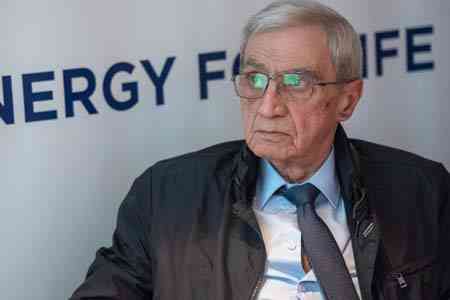


ArmInfo. Today is the deadline for the 2-month term for the expert opinion by the interagency group for construction of a new nuclear power unit formed under a decision by Armenia's Premier Nikol Pashinyan.
Talking to ArmInfo Advisor to the Director General of the Armenian Nuclear Power Plant (ANPP) Gera Sevikyan said that Armenia needs an already tested nuclear power unit, which has already confirmed its effectiveness with its work. "We have no right to experiment. There are very tempting proposals on the issue of building a new nuclear power unit, but we will not take risks," said the adviser to the general director. He added that if we are talking about a block of Russian design, then we can talk about a block with a capacity of 1000 and 1200 megawatts. At the same time, large operating time is observed in units with 1 thousand MW. "These are proven units that are constantly being upgraded to improve their safety," Sevikyan stressed.
At the same time, he urged not to make hasty decisions about the preferences of the Armenian side in favor of this or that reactor. Moreover, there are good offers from the Chinese, Koreans and Americans.
True, the proposals of the American side look beautiful only on paper, since the implementation of the American project may cause big problems associated with the transportation of large-modular equipment for the AP-1000 project, which are very bulky and heavy. The smallest equipment weighs 800 tons, which is simply impossible to bring to Armenia due to the lack of such roads, tunnels and bridges. "Besides, when you build something, there are a million side problems. In particular, large American modules do not fit together well, you have to work them out on the spot. The same can be said about the good-looking Korean version of the SPR-1000 reactor, which has not yet been built anywhere. For this reason, the possibility of building a modernized version of the Korean block KSTAR, which is better than its previous counterpart, is being studied.
Sevikyan noted that talks about the possibility of building power units with a capacity of 300-400 megawatts and small modular reactors in the republic remain just talks. "These are just developments, but in practice there are simply no such units, they are either in the project, or under construction, or have worked for a short period of time," the specialist noted, pointing out the importance of nuclear energy for the further development of the country's economy, especially given the depletion of resources hydropower. Decarbonization is underway around the world, and thermal power plants running on gas or coal will have to give way to nuclear power plants and renewable energy sources.
Sevikyan noted that by 2036, when the new unit should start operating, the second power unit will be decommissioned.
Armenian NPP, Hrazdan and Yerevan TPPs with a total installed capacity of 1,000 MW. Considering that the current bloc located at an altitude of over 600 meters above sea level, power of the new unit will be 10% less than 1 thousand MW.
In turn, the UN national energy expert Ara Marjanyan, in an interview with corr. ArmInfo stressed that the expert community of Armenia is inclined to the need to abandon experiments in nuclear energy, calling for the use of well-proven solutions. "Today, the world already uses reactors with a century of operation (60 years with the possibility of extension for another 40 years). It seems to me that Armenia should decide in favor of just such reactors," the expert said.
Earlier, the Minister of Territorial Administration and Infrastructures of the Republic of Armenia Gnel Sanosyan said that the government would make a decision on the new block by the end of this year. At the same time, indicators such as long-term economic growth rates, population growth, possible volumes of electricity exports and other factors will be taken into account.
The issue of building a new nuclear power unit in Armenia is fixed in the Strategy for the development of the country's nuclear energy until 2040. The issue currently being discussed concerns the capacity of the new power unit. Of all the possible options, only the Russian side presented its proposal. On June 8 this year in Sochi, as part of a meeting of the CIS Intergovernmental Council, the Prime Ministers of Russia and Armenia Mikhail Mishustin and Nikol Pashinyan visited the exhibition "Eurasia is our home", at which Pashinyan was told about the youngest and most efficient station in the world at the stand of the Rosatom State Corporation - a joint Russian-Belarusian NPP project. Mishustin drew Pashinyan's attention to the system of financing the project, pointing out that its cost "was mastered by a little more than 40% by Belarusian companies." The Russian prime minister suggested that Alexei Likhachev, the head of the Rosatom State Corporation, participating in the discussions, invite his Armenian colleagues and "talk, among other things, about the price of productivity."
At the end of May this year. Maria Longhi, coordinator of US government assistance programs for Europe and Eurasia, reported that the United States is considering the option of building small modular nuclear reactors in Armenia and other Eurasian states, seeking to strengthen their energy independence. According to her, in a number of countries, including Armenia, "the United States is evaluating the possibility of creating small modular nuclear reactors built using American technology and capable of leading to greater energy independence from both Russia and China.